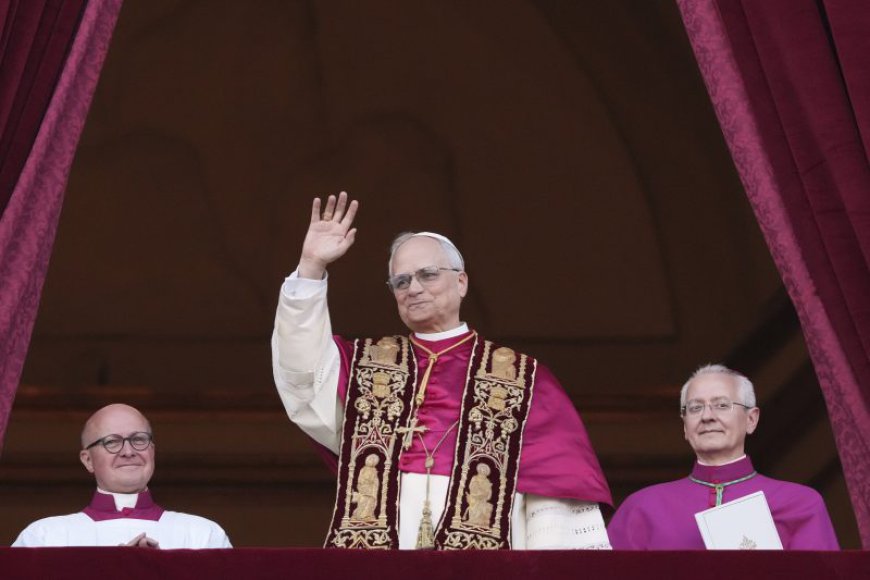Robert Prevost becomes first American pope of the Catholic Church: What to know

VATICAN CITY (AP) — Cardinal Robert Prevost, a missionary who spent his career ministering in Peru and leads the Vatican’s powerful office of bishops, was elected the first American pope in the 2,000-year history of the Catholic Church.
Prevost, who took the name Leo XIV, said “Peace be with you” in his first words as pope, offering a message of peace and dialogue “without fear.”
He is the 267th pope to lead the Catholic Church, elected by his fellow cardinals on the second day of their conclave. Prevost appeared on the loggia of St. Peter's Square wearing the traditional red cape of the papacy — a cape that Pope Francis had eschewed on his election in 2013.
The crowd in St. Peter’s Square erupted in cheers, priests made the sign of the cross and nuns wept as the crowd shouted “Viva il papa!” after the white smoke wafted into the late afternoon sky at 6:07 p.m. Waving flags from around the world, tens of thousands of people waited to learn who had won.
From the loggia of St. Peter’s Basilica, history’s first American pope recalled he was an Augustinian priest, but that he was above all a Christian above all and a bishop, “So we can all walk together.”
Watch below: Live coverage from the Vatican
Prevost's recent work at the Vatican
Francis clearly had his eye on Prevost and, in many ways, saw him as his heir apparent.
Francis brought Prevost to the Vatican in 2023 to serve as the powerful head of the office that vets bishop nominations from around the world, one of the most important jobs in the Catholic Church. As a result, Prevost has a prominence going into the conclave that few other cardinals have.
Ever since he arrived in Rome, Prevost has kept a low public profile, but he is well known to the men who count.
Significantly, he presided over one of the most revolutionary reforms Francis made, when he added three women to the voting bloc that decides which bishop nominations to forward to the pope. In early 2025, Francis again showed his esteem by appointing Prevost to the most senior rank of cardinals, suggesting he would at least be Francis’ choice in an any future conclave.
The Rev. Fidel Purisaca Vigil, the communications director for Prevost’s old diocese in Chiclayo, remembers the cardinal rising each day and having breakfast with his fellow priests after saying his prayers.
“No matter how many problems he has, he maintains good humor and joy,” Purisaca said in an email.
Was Prevost a contender during the conclave?
Prevost had been a leading candidate except for his nationality.
One strike against him going into the conclave was that he’s American, and there has long been a taboo against a U.S. pope, given the geopolitical power already wielded by the United States in the secular sphere. But Prevost, a Chicago native, is also a Peruvian citizen and lived for years in Peru, first as a missionary and then as an archbishop.
Prevost was also twice elected prior general, or top leader, of the Augustinian religious order, the 13th century order founded by St. Augustine. Francis clearly had an eye on him for years, moving him from the Augustinian leadership back to Peru in 2014 to serve as the administrator and later archbishop of Chiclayo.
He remained in that position, acquiring Peruvian citizenship in 2015, until Francis brought him to Rome in 2023 to assume the presidency of the Pontifical Commission for Latin America. In that job he would have kept in regular contact with the Catholic hierarchy in the part of the world that counts still counts the most Catholics.
Prevost’s comparative youth was also viewed as a factor that could count against him if his brother cardinals didn’t want to commit to a pope who might reign for another two decades.
Developing
What's Your Reaction?
 Like
0
Like
0
 Dislike
0
Dislike
0
 Love
0
Love
0
 Funny
0
Funny
0
 Angry
0
Angry
0
 Sad
0
Sad
0
 Wow
0
Wow
0








































